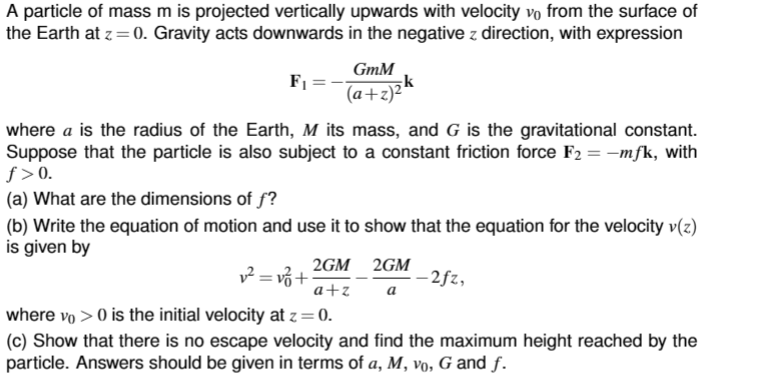A particle of mass m is projected vertically upwards with velocity vo from the surface of the Earth at z = 0. Gravity acts downwards in the negative z direction, with expression F₁ = where a is the radius of the Earth, M its mass, and G is the gravitational constant. Suppose that the particle is also subject to a constant friction force F2₂ = −mfk, with ƒ>0. GmM (a+z)² (a) What are the dimensions of f? (b) Write the equation of motion and use it to show that the equation for the velocity v(z) is given by v² = √√ + 2GM a+z where vo > 0 is the initial velocity at z = = 0. 2GM a -2fz, (c) Show that there is no escape velocity and find the maximum height reached by the particle. Answers should be given in terms of a, M, vo, G and f.
A particle of mass m is projected vertically upwards with velocity vo from the surface of the Earth at z = 0. Gravity acts downwards in the negative z direction, with expression F₁ = where a is the radius of the Earth, M its mass, and G is the gravitational constant. Suppose that the particle is also subject to a constant friction force F2₂ = −mfk, with ƒ>0. GmM (a+z)² (a) What are the dimensions of f? (b) Write the equation of motion and use it to show that the equation for the velocity v(z) is given by v² = √√ + 2GM a+z where vo > 0 is the initial velocity at z = = 0. 2GM a -2fz, (c) Show that there is no escape velocity and find the maximum height reached by the particle. Answers should be given in terms of a, M, vo, G and f.
Physics for Scientists and Engineers: Foundations and Connections
1st Edition
ISBN:9781133939146
Author:Katz, Debora M.
Publisher:Katz, Debora M.
Chapter7: Gravity
Section: Chapter Questions
Problem 38PQ
Related questions
Topic Video
Question

Transcribed Image Text:A particle of mass m is projected vertically upwards with velocity vo from the surface of
the Earth at z = 0. Gravity acts downwards in the negative z direction, with expression
F₁
=
GmM
(a+z)²
where a is the radius of the Earth, M its mass, and G is the gravitational constant.
Suppose that the particle is also subject to a constant friction force F₂ = -mfk, with
ƒ>0.
(a) What are the dimensions of f?
(b) Write the equation of motion and use it to show that the equation for the velocity v(z)
is given by
v² = v₁ +
2GM
a+z
where vo> 0 is the initial velocity at z = 0.
(c) Show that there is no escape velocity and find the maximum height reached by the
particle. Answers should be given in terms of a, M, vo, G and f.
2GM
a
-2fz,
Expert Solution
This question has been solved!
Explore an expertly crafted, step-by-step solution for a thorough understanding of key concepts.
This is a popular solution!
Trending now
This is a popular solution!
Step by step
Solved in 5 steps

Knowledge Booster
Learn more about
Need a deep-dive on the concept behind this application? Look no further. Learn more about this topic, physics and related others by exploring similar questions and additional content below.Recommended textbooks for you

Physics for Scientists and Engineers: Foundations…
Physics
ISBN:
9781133939146
Author:
Katz, Debora M.
Publisher:
Cengage Learning

Principles of Physics: A Calculus-Based Text
Physics
ISBN:
9781133104261
Author:
Raymond A. Serway, John W. Jewett
Publisher:
Cengage Learning

Classical Dynamics of Particles and Systems
Physics
ISBN:
9780534408961
Author:
Stephen T. Thornton, Jerry B. Marion
Publisher:
Cengage Learning

Physics for Scientists and Engineers: Foundations…
Physics
ISBN:
9781133939146
Author:
Katz, Debora M.
Publisher:
Cengage Learning

Principles of Physics: A Calculus-Based Text
Physics
ISBN:
9781133104261
Author:
Raymond A. Serway, John W. Jewett
Publisher:
Cengage Learning

Classical Dynamics of Particles and Systems
Physics
ISBN:
9780534408961
Author:
Stephen T. Thornton, Jerry B. Marion
Publisher:
Cengage Learning

University Physics Volume 1
Physics
ISBN:
9781938168277
Author:
William Moebs, Samuel J. Ling, Jeff Sanny
Publisher:
OpenStax - Rice University